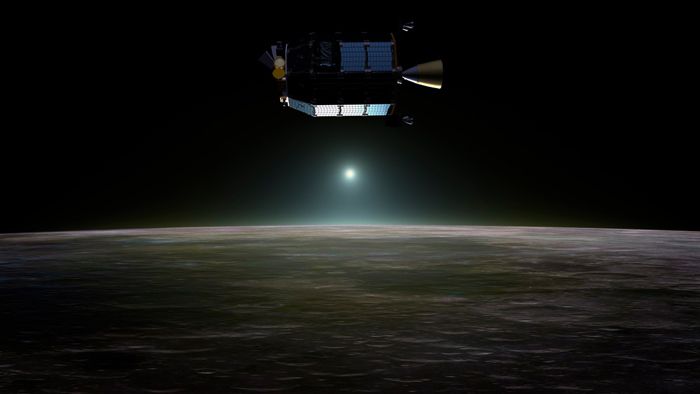RIP LADEE: NASA Moon Probe Crashes Into Lunar Surface

NASA's newest moon probe met its end during a vaporizing crash into the lunar surface last night.
The space agency's Lunar Atmosphere and Dust Environment Explorer spacecraft (LADEE for short) made its planned crash into the lunar surface between 12:30 a.m. EDT (0430 GMT) and 1:22 a.m. EDT (0522 GMT) on April 18, after orbiting the moon since October 2013. Scientists expected the impact, predicting that LADEE would hit the far side of the moon on or before April 21 because the probe was running out of fuel — as intended.
The impact itself was probably a violent event. NASA engineers think that the loveseat-sized probe broke apart as most of it heated up to several hundred degrees. It's even possible that some of the material from the spacecraft vaporized during the crash, NASA officials said in a statement. [The Greatest Moon Crashes of All Time]
"At the time of impact, LADEE was traveling at a speed of 3,600 miles per hour [5,800 km/h] — about three times the speed of a high-powered rifle bullet," Rick Elphic, LADEE project scientist at NASA's Ames Research Center in California, said in a statement. "There's nothing gentle about impact at these speeds — it's just a question of whether LADEE made a localized craterlet on a hillside or scattered debris across a flat area. It will be interesting to see what kind of feature LADEE has created."
NASA will use another probe still orbiting the moon to seek out LADEE's crash site and learn more about the impact. Scientists will use the space agency's Lunar Reconnaissance Orbiter to try to snap a picture of the LADEE impact site. The site itself is not viewable from Earth, and it is far from any area where previous moon landings occurred, NASA officials said.
Before its impact, LADEE dropped down to altitudes below 1 mile (1.6 kilometers) above the surface of the moon, allowing researchers to collect unprecedented data, NASA officials said.
"LADEE was a mission of firsts, achieving yet another first by successfully flying more than 100 orbits at extremely low altitudes," said Joan Salute, LADEE program executive at NASA headquarters in Washington. "Although a risky decision, we're already seeing evidence that the risk was worth taking.”
Sign up for the Live Science daily newsletter now
Get the world’s most fascinating discoveries delivered straight to your inbox.
The $280 million LADEE mission launched to space in September 2013 to investigate the moon's thin atmosphere and help scientists learn more about lunar dust. In particular, the spacecraft was designed to investigate a moon dust mystery that dates back to before the Apollo era.
During the Apollo missions, some astronauts saw a glow on the horizon before sunrise as they orbited above the moon's surface. Earlier NASA probes also caught sight of that distinct glow. Scientists think that particles of dust lofted into the thin lunar atmosphere (called an exosphere) may have caused the glow; however, data collected by LADEE has not yet confirmed this theory.
LADEE also helped scientists learn more about the moon's exosphere. Researchers think that exospheres are the most common type of atmosphere in the solar system, so learning more about the lunar atmosphere could tell researchers more about other bodies in the solar system, like Mercury.
The small probe also survived the total lunar eclipse on April 14 to 15, making it through the low temperatures and battery drain it experienced when out of direct sunlight.
"It's bittersweet knowing we have received the final transmission from the LADEE spacecraft after spending years building it in-house at Ames, and then being in constant contact as it circled the moon for the last several months," Butler Hine, LADEE project manager at Ames, said in a statement.
Follow Miriam Kramer @mirikramer and Google+. Follow us @Spacedotcom, Facebook and Google+. Original article on Space.com.













